An Analysis of Ethnicity and Migration in Contemporary Australia
VerifiedAdded on 2023/03/17
|11
|3069
|70
Essay
AI Summary
This essay provides a comprehensive overview of ethnicity and migration in Australia, examining various factors that influence these dynamics. It begins with a historical perspective, tracing migration patterns from the stone age to the present day, with a specific focus on Australia's immigration trends. The essay explores the impact of globalization, transnationalism, the internet, social media, and new technologies on migration, highlighting both positive and negative consequences. It delves into how social media facilitates communication and information access for migrants, while also considering barriers to movement such as security threats and visa restrictions. The essay further analyzes how mobility differs among various groups, influenced by social class and status, and discusses the reasons behind backlashes against migration and globalization. Finally, it examines the consequences of these backlashes, including impacts on living standards and cultural integration. The essay draws upon various sociological studies and research papers to support its arguments, providing a well-rounded perspective on the complexities of migration and ethnicity in Australia.
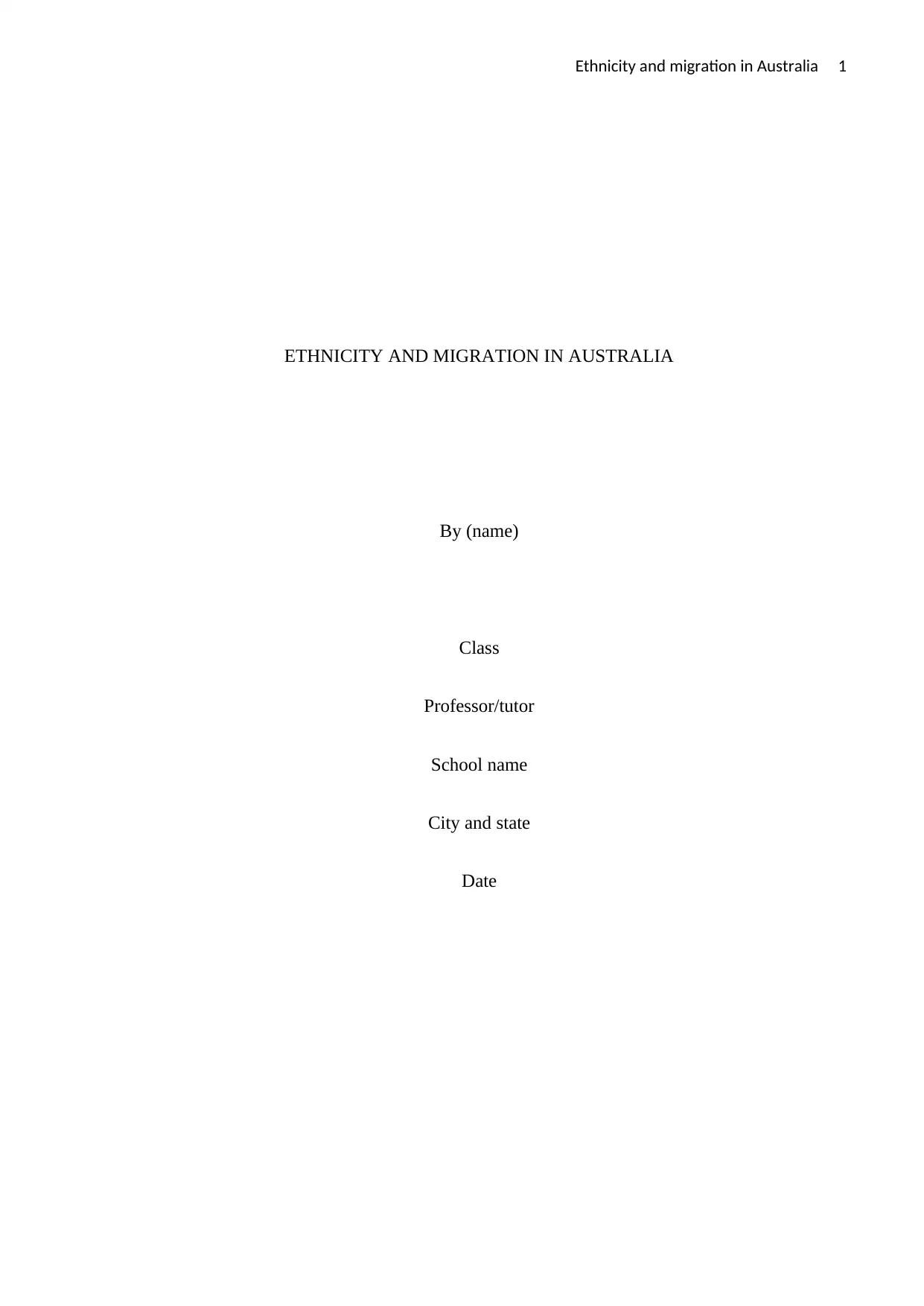
Ethnicity and migration in Australia 1
ETHNICITY AND MIGRATION IN AUSTRALIA
By (name)
Class
Professor/tutor
School name
City and state
Date
ETHNICITY AND MIGRATION IN AUSTRALIA
By (name)
Class
Professor/tutor
School name
City and state
Date
Paraphrase This Document
Need a fresh take? Get an instant paraphrase of this document with our AI Paraphraser
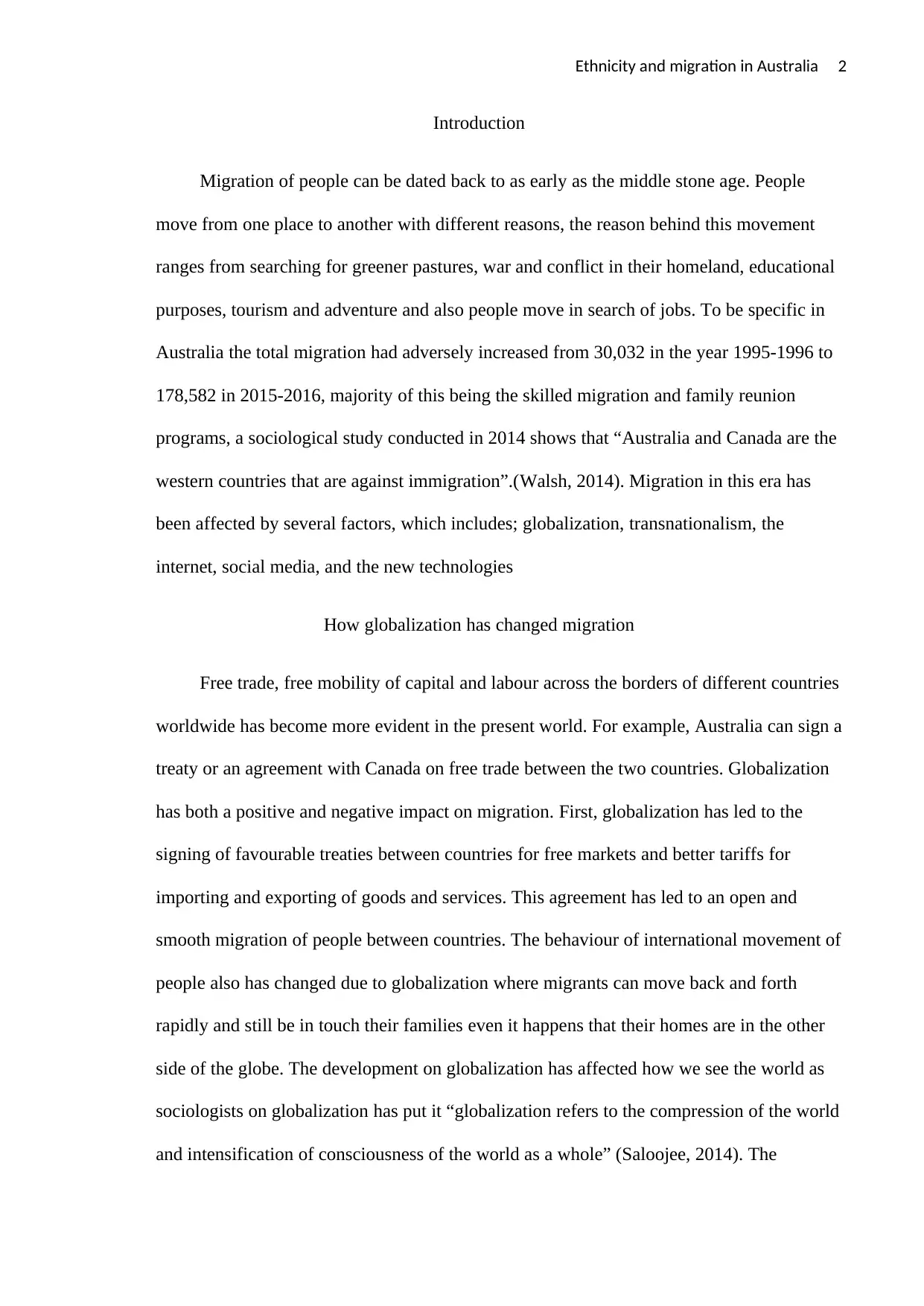
Ethnicity and migration in Australia 2
Introduction
Migration of people can be dated back to as early as the middle stone age. People
move from one place to another with different reasons, the reason behind this movement
ranges from searching for greener pastures, war and conflict in their homeland, educational
purposes, tourism and adventure and also people move in search of jobs. To be specific in
Australia the total migration had adversely increased from 30,032 in the year 1995-1996 to
178,582 in 2015-2016, majority of this being the skilled migration and family reunion
programs, a sociological study conducted in 2014 shows that “Australia and Canada are the
western countries that are against immigration”.(Walsh, 2014). Migration in this era has
been affected by several factors, which includes; globalization, transnationalism, the
internet, social media, and the new technologies
How globalization has changed migration
Free trade, free mobility of capital and labour across the borders of different countries
worldwide has become more evident in the present world. For example, Australia can sign a
treaty or an agreement with Canada on free trade between the two countries. Globalization
has both a positive and negative impact on migration. First, globalization has led to the
signing of favourable treaties between countries for free markets and better tariffs for
importing and exporting of goods and services. This agreement has led to an open and
smooth migration of people between countries. The behaviour of international movement of
people also has changed due to globalization where migrants can move back and forth
rapidly and still be in touch their families even it happens that their homes are in the other
side of the globe. The development on globalization has affected how we see the world as
sociologists on globalization has put it “globalization refers to the compression of the world
and intensification of consciousness of the world as a whole” (Saloojee, 2014). The
Introduction
Migration of people can be dated back to as early as the middle stone age. People
move from one place to another with different reasons, the reason behind this movement
ranges from searching for greener pastures, war and conflict in their homeland, educational
purposes, tourism and adventure and also people move in search of jobs. To be specific in
Australia the total migration had adversely increased from 30,032 in the year 1995-1996 to
178,582 in 2015-2016, majority of this being the skilled migration and family reunion
programs, a sociological study conducted in 2014 shows that “Australia and Canada are the
western countries that are against immigration”.(Walsh, 2014). Migration in this era has
been affected by several factors, which includes; globalization, transnationalism, the
internet, social media, and the new technologies
How globalization has changed migration
Free trade, free mobility of capital and labour across the borders of different countries
worldwide has become more evident in the present world. For example, Australia can sign a
treaty or an agreement with Canada on free trade between the two countries. Globalization
has both a positive and negative impact on migration. First, globalization has led to the
signing of favourable treaties between countries for free markets and better tariffs for
importing and exporting of goods and services. This agreement has led to an open and
smooth migration of people between countries. The behaviour of international movement of
people also has changed due to globalization where migrants can move back and forth
rapidly and still be in touch their families even it happens that their homes are in the other
side of the globe. The development on globalization has affected how we see the world as
sociologists on globalization has put it “globalization refers to the compression of the world
and intensification of consciousness of the world as a whole” (Saloojee, 2014). The
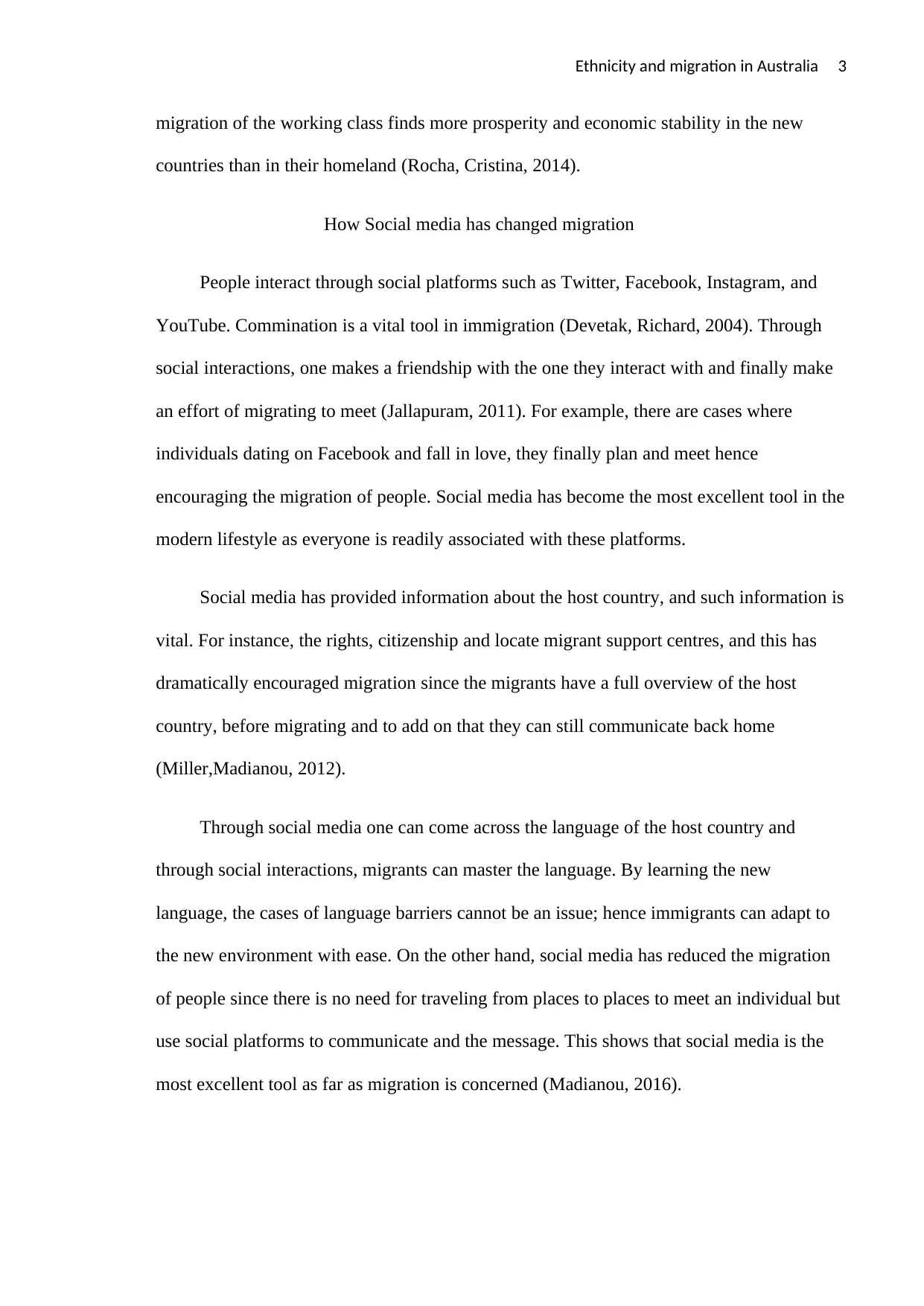
Ethnicity and migration in Australia 3
migration of the working class finds more prosperity and economic stability in the new
countries than in their homeland (Rocha, Cristina, 2014).
How Social media has changed migration
People interact through social platforms such as Twitter, Facebook, Instagram, and
YouTube. Commination is a vital tool in immigration (Devetak, Richard, 2004). Through
social interactions, one makes a friendship with the one they interact with and finally make
an effort of migrating to meet (Jallapuram, 2011). For example, there are cases where
individuals dating on Facebook and fall in love, they finally plan and meet hence
encouraging the migration of people. Social media has become the most excellent tool in the
modern lifestyle as everyone is readily associated with these platforms.
Social media has provided information about the host country, and such information is
vital. For instance, the rights, citizenship and locate migrant support centres, and this has
dramatically encouraged migration since the migrants have a full overview of the host
country, before migrating and to add on that they can still communicate back home
(Miller,Madianou, 2012).
Through social media one can come across the language of the host country and
through social interactions, migrants can master the language. By learning the new
language, the cases of language barriers cannot be an issue; hence immigrants can adapt to
the new environment with ease. On the other hand, social media has reduced the migration
of people since there is no need for traveling from places to places to meet an individual but
use social platforms to communicate and the message. This shows that social media is the
most excellent tool as far as migration is concerned (Madianou, 2016).
migration of the working class finds more prosperity and economic stability in the new
countries than in their homeland (Rocha, Cristina, 2014).
How Social media has changed migration
People interact through social platforms such as Twitter, Facebook, Instagram, and
YouTube. Commination is a vital tool in immigration (Devetak, Richard, 2004). Through
social interactions, one makes a friendship with the one they interact with and finally make
an effort of migrating to meet (Jallapuram, 2011). For example, there are cases where
individuals dating on Facebook and fall in love, they finally plan and meet hence
encouraging the migration of people. Social media has become the most excellent tool in the
modern lifestyle as everyone is readily associated with these platforms.
Social media has provided information about the host country, and such information is
vital. For instance, the rights, citizenship and locate migrant support centres, and this has
dramatically encouraged migration since the migrants have a full overview of the host
country, before migrating and to add on that they can still communicate back home
(Miller,Madianou, 2012).
Through social media one can come across the language of the host country and
through social interactions, migrants can master the language. By learning the new
language, the cases of language barriers cannot be an issue; hence immigrants can adapt to
the new environment with ease. On the other hand, social media has reduced the migration
of people since there is no need for traveling from places to places to meet an individual but
use social platforms to communicate and the message. This shows that social media is the
most excellent tool as far as migration is concerned (Madianou, 2016).
⊘ This is a preview!⊘
Do you want full access?
Subscribe today to unlock all pages.

Trusted by 1+ million students worldwide
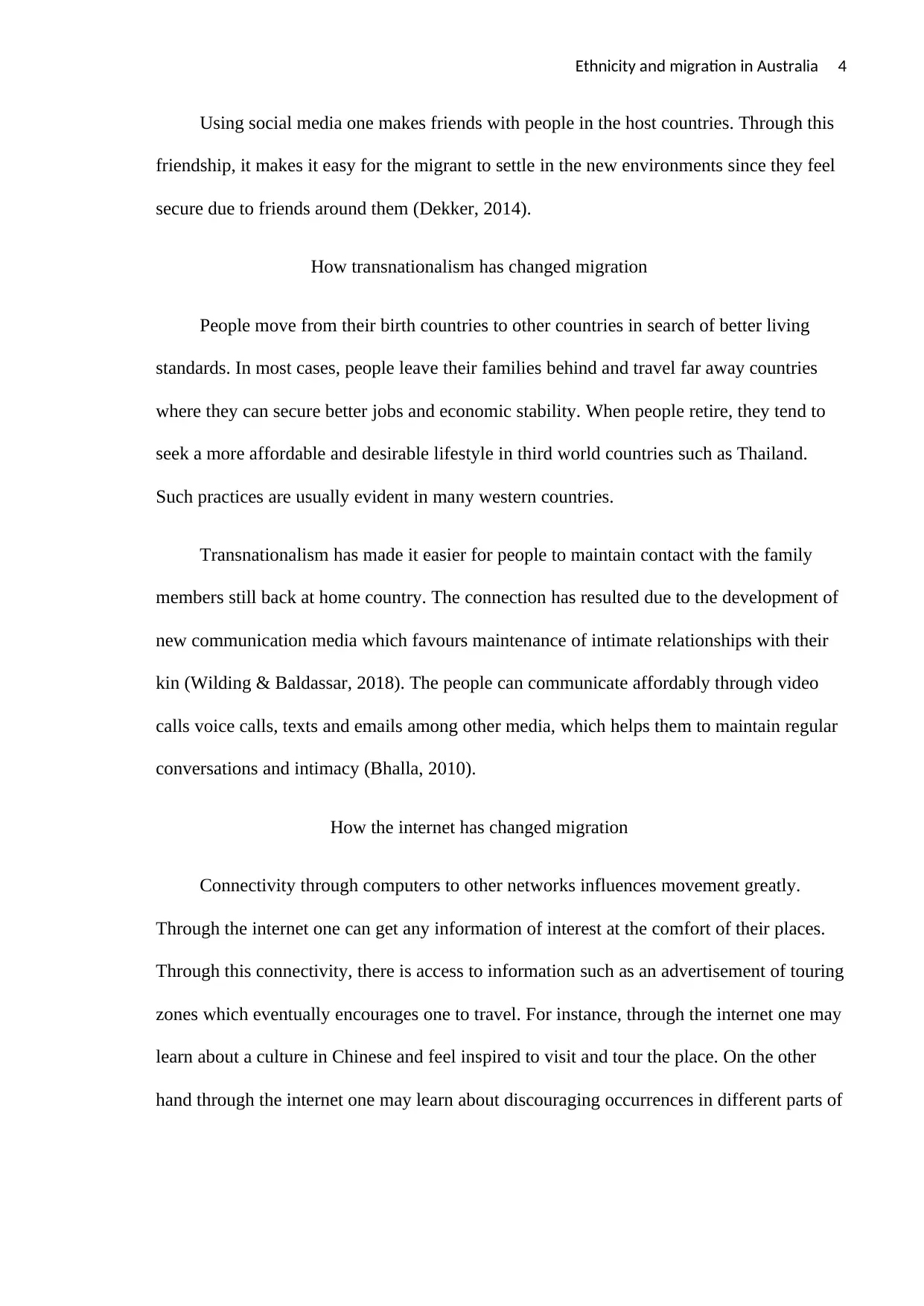
Ethnicity and migration in Australia 4
Using social media one makes friends with people in the host countries. Through this
friendship, it makes it easy for the migrant to settle in the new environments since they feel
secure due to friends around them (Dekker, 2014).
How transnationalism has changed migration
People move from their birth countries to other countries in search of better living
standards. In most cases, people leave their families behind and travel far away countries
where they can secure better jobs and economic stability. When people retire, they tend to
seek a more affordable and desirable lifestyle in third world countries such as Thailand.
Such practices are usually evident in many western countries.
Transnationalism has made it easier for people to maintain contact with the family
members still back at home country. The connection has resulted due to the development of
new communication media which favours maintenance of intimate relationships with their
kin (Wilding & Baldassar, 2018). The people can communicate affordably through video
calls voice calls, texts and emails among other media, which helps them to maintain regular
conversations and intimacy (Bhalla, 2010).
How the internet has changed migration
Connectivity through computers to other networks influences movement greatly.
Through the internet one can get any information of interest at the comfort of their places.
Through this connectivity, there is access to information such as an advertisement of touring
zones which eventually encourages one to travel. For instance, through the internet one may
learn about a culture in Chinese and feel inspired to visit and tour the place. On the other
hand through the internet one may learn about discouraging occurrences in different parts of
Using social media one makes friends with people in the host countries. Through this
friendship, it makes it easy for the migrant to settle in the new environments since they feel
secure due to friends around them (Dekker, 2014).
How transnationalism has changed migration
People move from their birth countries to other countries in search of better living
standards. In most cases, people leave their families behind and travel far away countries
where they can secure better jobs and economic stability. When people retire, they tend to
seek a more affordable and desirable lifestyle in third world countries such as Thailand.
Such practices are usually evident in many western countries.
Transnationalism has made it easier for people to maintain contact with the family
members still back at home country. The connection has resulted due to the development of
new communication media which favours maintenance of intimate relationships with their
kin (Wilding & Baldassar, 2018). The people can communicate affordably through video
calls voice calls, texts and emails among other media, which helps them to maintain regular
conversations and intimacy (Bhalla, 2010).
How the internet has changed migration
Connectivity through computers to other networks influences movement greatly.
Through the internet one can get any information of interest at the comfort of their places.
Through this connectivity, there is access to information such as an advertisement of touring
zones which eventually encourages one to travel. For instance, through the internet one may
learn about a culture in Chinese and feel inspired to visit and tour the place. On the other
hand through the internet one may learn about discouraging occurrences in different parts of
Paraphrase This Document
Need a fresh take? Get an instant paraphrase of this document with our AI Paraphraser
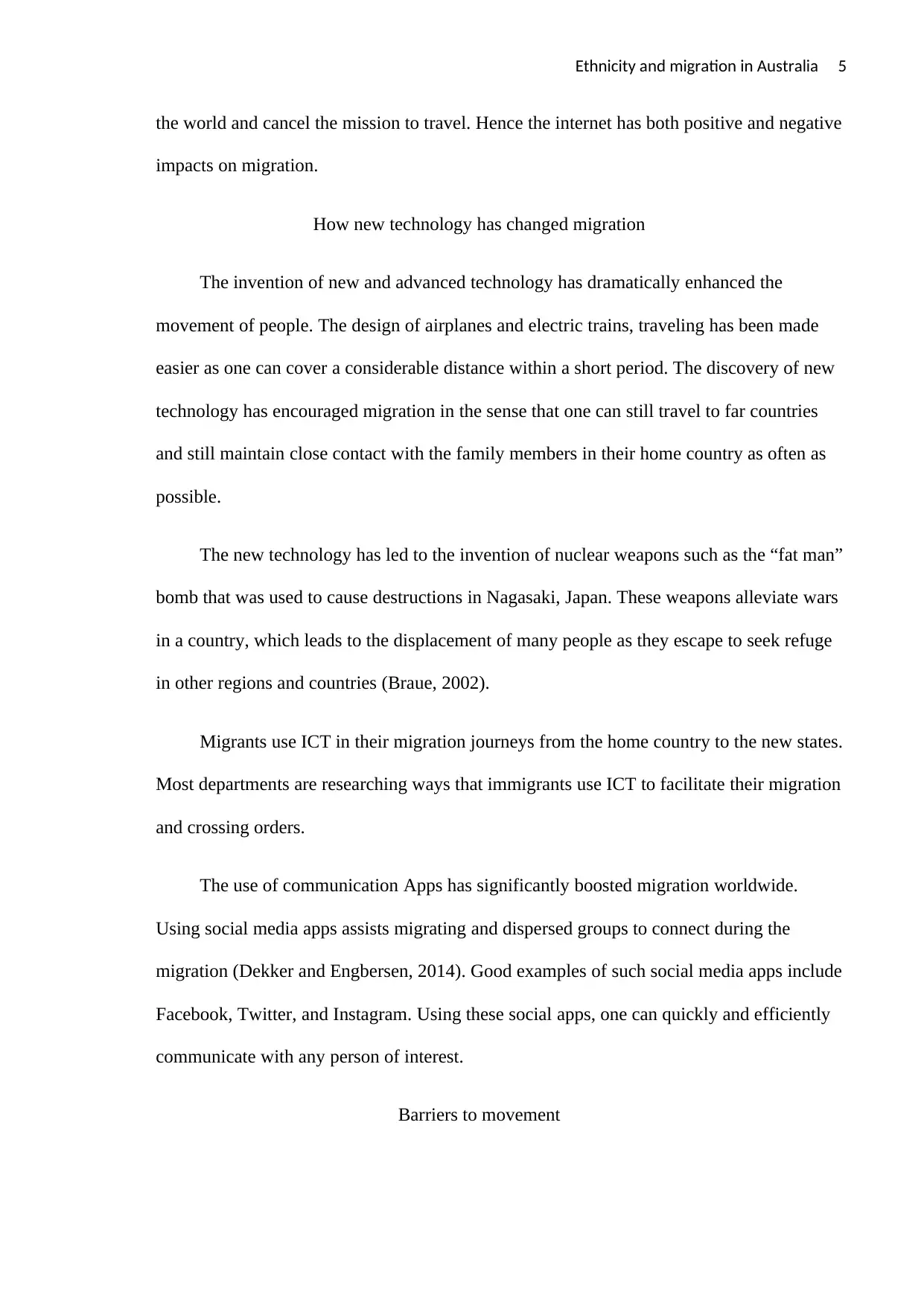
Ethnicity and migration in Australia 5
the world and cancel the mission to travel. Hence the internet has both positive and negative
impacts on migration.
How new technology has changed migration
The invention of new and advanced technology has dramatically enhanced the
movement of people. The design of airplanes and electric trains, traveling has been made
easier as one can cover a considerable distance within a short period. The discovery of new
technology has encouraged migration in the sense that one can still travel to far countries
and still maintain close contact with the family members in their home country as often as
possible.
The new technology has led to the invention of nuclear weapons such as the “fat man”
bomb that was used to cause destructions in Nagasaki, Japan. These weapons alleviate wars
in a country, which leads to the displacement of many people as they escape to seek refuge
in other regions and countries (Braue, 2002).
Migrants use ICT in their migration journeys from the home country to the new states.
Most departments are researching ways that immigrants use ICT to facilitate their migration
and crossing orders.
The use of communication Apps has significantly boosted migration worldwide.
Using social media apps assists migrating and dispersed groups to connect during the
migration (Dekker and Engbersen, 2014). Good examples of such social media apps include
Facebook, Twitter, and Instagram. Using these social apps, one can quickly and efficiently
communicate with any person of interest.
Barriers to movement
the world and cancel the mission to travel. Hence the internet has both positive and negative
impacts on migration.
How new technology has changed migration
The invention of new and advanced technology has dramatically enhanced the
movement of people. The design of airplanes and electric trains, traveling has been made
easier as one can cover a considerable distance within a short period. The discovery of new
technology has encouraged migration in the sense that one can still travel to far countries
and still maintain close contact with the family members in their home country as often as
possible.
The new technology has led to the invention of nuclear weapons such as the “fat man”
bomb that was used to cause destructions in Nagasaki, Japan. These weapons alleviate wars
in a country, which leads to the displacement of many people as they escape to seek refuge
in other regions and countries (Braue, 2002).
Migrants use ICT in their migration journeys from the home country to the new states.
Most departments are researching ways that immigrants use ICT to facilitate their migration
and crossing orders.
The use of communication Apps has significantly boosted migration worldwide.
Using social media apps assists migrating and dispersed groups to connect during the
migration (Dekker and Engbersen, 2014). Good examples of such social media apps include
Facebook, Twitter, and Instagram. Using these social apps, one can quickly and efficiently
communicate with any person of interest.
Barriers to movement
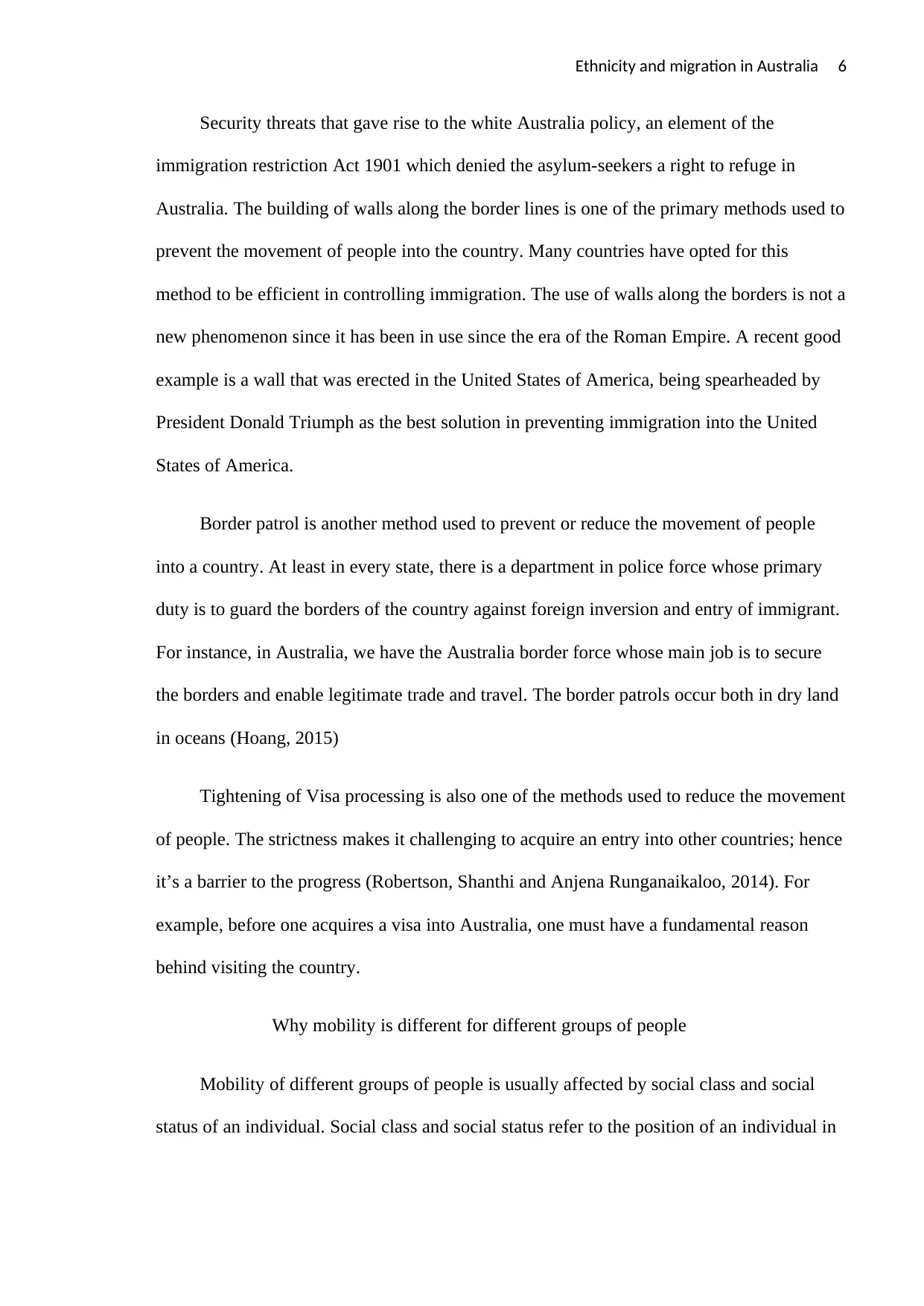
Ethnicity and migration in Australia 6
Security threats that gave rise to the white Australia policy, an element of the
immigration restriction Act 1901 which denied the asylum-seekers a right to refuge in
Australia. The building of walls along the border lines is one of the primary methods used to
prevent the movement of people into the country. Many countries have opted for this
method to be efficient in controlling immigration. The use of walls along the borders is not a
new phenomenon since it has been in use since the era of the Roman Empire. A recent good
example is a wall that was erected in the United States of America, being spearheaded by
President Donald Triumph as the best solution in preventing immigration into the United
States of America.
Border patrol is another method used to prevent or reduce the movement of people
into a country. At least in every state, there is a department in police force whose primary
duty is to guard the borders of the country against foreign inversion and entry of immigrant.
For instance, in Australia, we have the Australia border force whose main job is to secure
the borders and enable legitimate trade and travel. The border patrols occur both in dry land
in oceans (Hoang, 2015)
Tightening of Visa processing is also one of the methods used to reduce the movement
of people. The strictness makes it challenging to acquire an entry into other countries; hence
it’s a barrier to the progress (Robertson, Shanthi and Anjena Runganaikaloo, 2014). For
example, before one acquires a visa into Australia, one must have a fundamental reason
behind visiting the country.
Why mobility is different for different groups of people
Mobility of different groups of people is usually affected by social class and social
status of an individual. Social class and social status refer to the position of an individual in
Security threats that gave rise to the white Australia policy, an element of the
immigration restriction Act 1901 which denied the asylum-seekers a right to refuge in
Australia. The building of walls along the border lines is one of the primary methods used to
prevent the movement of people into the country. Many countries have opted for this
method to be efficient in controlling immigration. The use of walls along the borders is not a
new phenomenon since it has been in use since the era of the Roman Empire. A recent good
example is a wall that was erected in the United States of America, being spearheaded by
President Donald Triumph as the best solution in preventing immigration into the United
States of America.
Border patrol is another method used to prevent or reduce the movement of people
into a country. At least in every state, there is a department in police force whose primary
duty is to guard the borders of the country against foreign inversion and entry of immigrant.
For instance, in Australia, we have the Australia border force whose main job is to secure
the borders and enable legitimate trade and travel. The border patrols occur both in dry land
in oceans (Hoang, 2015)
Tightening of Visa processing is also one of the methods used to reduce the movement
of people. The strictness makes it challenging to acquire an entry into other countries; hence
it’s a barrier to the progress (Robertson, Shanthi and Anjena Runganaikaloo, 2014). For
example, before one acquires a visa into Australia, one must have a fundamental reason
behind visiting the country.
Why mobility is different for different groups of people
Mobility of different groups of people is usually affected by social class and social
status of an individual. Social class and social status refer to the position of an individual in
⊘ This is a preview!⊘
Do you want full access?
Subscribe today to unlock all pages.

Trusted by 1+ million students worldwide
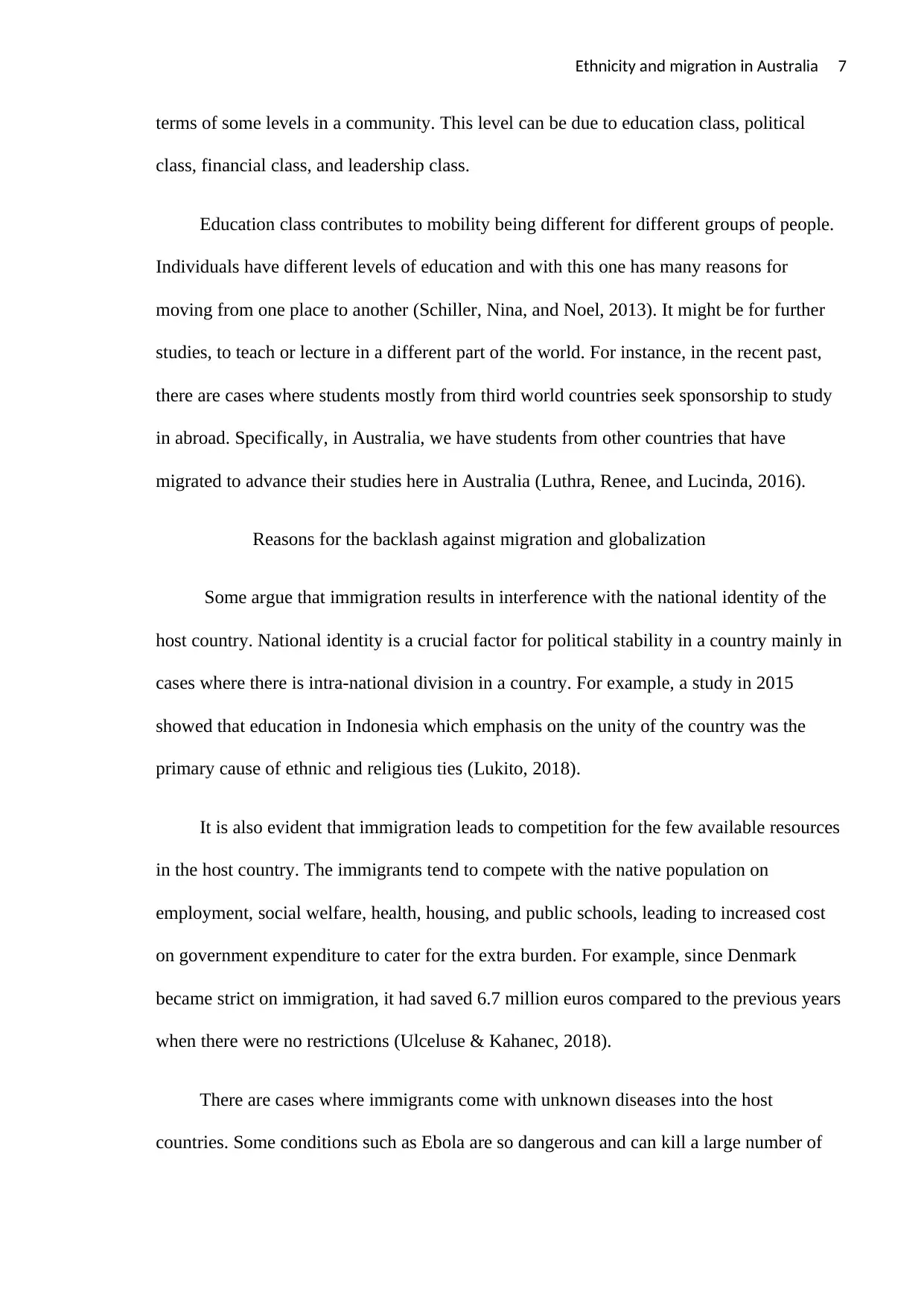
Ethnicity and migration in Australia 7
terms of some levels in a community. This level can be due to education class, political
class, financial class, and leadership class.
Education class contributes to mobility being different for different groups of people.
Individuals have different levels of education and with this one has many reasons for
moving from one place to another (Schiller, Nina, and Noel, 2013). It might be for further
studies, to teach or lecture in a different part of the world. For instance, in the recent past,
there are cases where students mostly from third world countries seek sponsorship to study
in abroad. Specifically, in Australia, we have students from other countries that have
migrated to advance their studies here in Australia (Luthra, Renee, and Lucinda, 2016).
Reasons for the backlash against migration and globalization
Some argue that immigration results in interference with the national identity of the
host country. National identity is a crucial factor for political stability in a country mainly in
cases where there is intra-national division in a country. For example, a study in 2015
showed that education in Indonesia which emphasis on the unity of the country was the
primary cause of ethnic and religious ties (Lukito, 2018).
It is also evident that immigration leads to competition for the few available resources
in the host country. The immigrants tend to compete with the native population on
employment, social welfare, health, housing, and public schools, leading to increased cost
on government expenditure to cater for the extra burden. For example, since Denmark
became strict on immigration, it had saved 6.7 million euros compared to the previous years
when there were no restrictions (Ulceluse & Kahanec, 2018).
There are cases where immigrants come with unknown diseases into the host
countries. Some conditions such as Ebola are so dangerous and can kill a large number of
terms of some levels in a community. This level can be due to education class, political
class, financial class, and leadership class.
Education class contributes to mobility being different for different groups of people.
Individuals have different levels of education and with this one has many reasons for
moving from one place to another (Schiller, Nina, and Noel, 2013). It might be for further
studies, to teach or lecture in a different part of the world. For instance, in the recent past,
there are cases where students mostly from third world countries seek sponsorship to study
in abroad. Specifically, in Australia, we have students from other countries that have
migrated to advance their studies here in Australia (Luthra, Renee, and Lucinda, 2016).
Reasons for the backlash against migration and globalization
Some argue that immigration results in interference with the national identity of the
host country. National identity is a crucial factor for political stability in a country mainly in
cases where there is intra-national division in a country. For example, a study in 2015
showed that education in Indonesia which emphasis on the unity of the country was the
primary cause of ethnic and religious ties (Lukito, 2018).
It is also evident that immigration leads to competition for the few available resources
in the host country. The immigrants tend to compete with the native population on
employment, social welfare, health, housing, and public schools, leading to increased cost
on government expenditure to cater for the extra burden. For example, since Denmark
became strict on immigration, it had saved 6.7 million euros compared to the previous years
when there were no restrictions (Ulceluse & Kahanec, 2018).
There are cases where immigrants come with unknown diseases into the host
countries. Some conditions such as Ebola are so dangerous and can kill a large number of
Paraphrase This Document
Need a fresh take? Get an instant paraphrase of this document with our AI Paraphraser
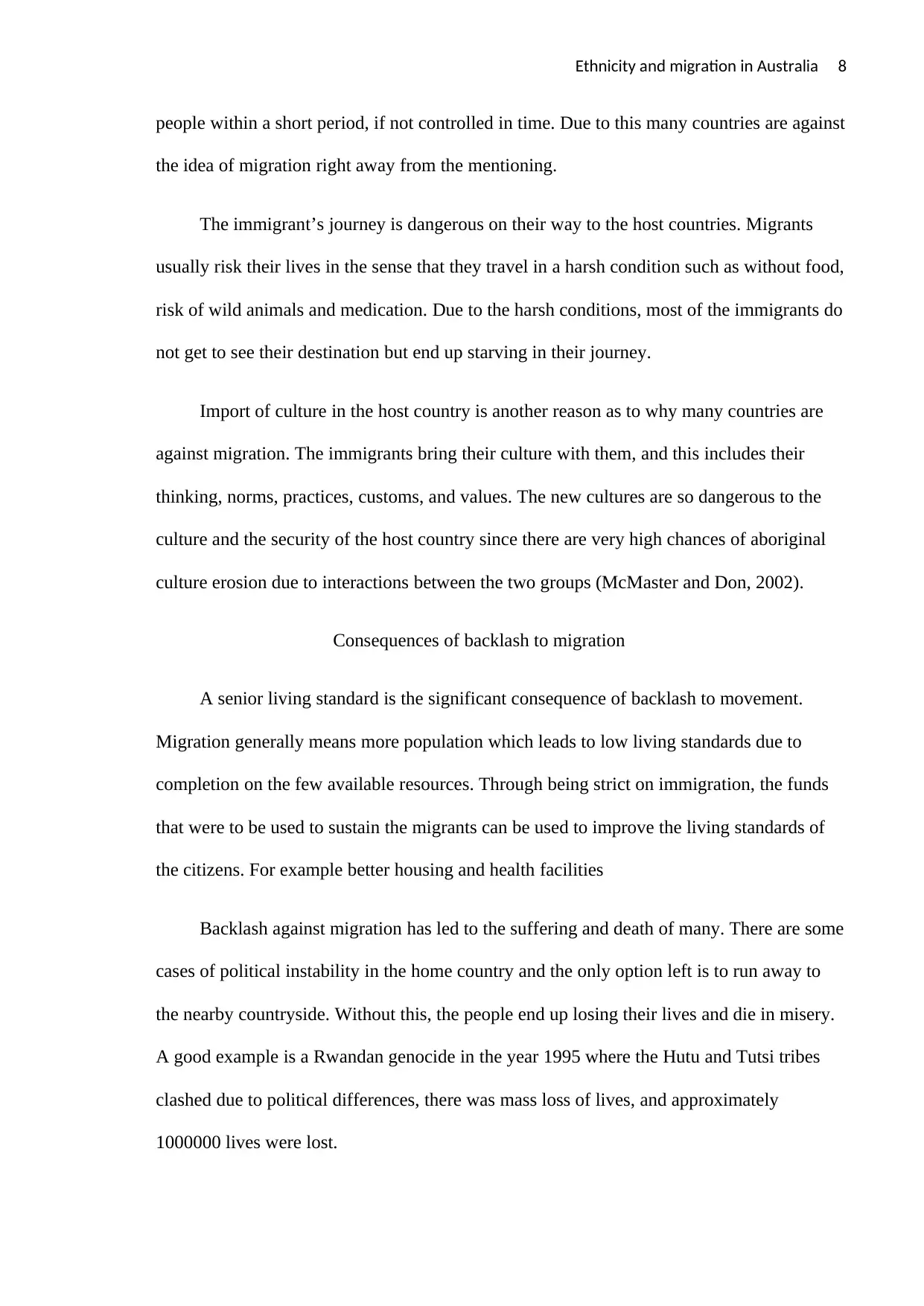
Ethnicity and migration in Australia 8
people within a short period, if not controlled in time. Due to this many countries are against
the idea of migration right away from the mentioning.
The immigrant’s journey is dangerous on their way to the host countries. Migrants
usually risk their lives in the sense that they travel in a harsh condition such as without food,
risk of wild animals and medication. Due to the harsh conditions, most of the immigrants do
not get to see their destination but end up starving in their journey.
Import of culture in the host country is another reason as to why many countries are
against migration. The immigrants bring their culture with them, and this includes their
thinking, norms, practices, customs, and values. The new cultures are so dangerous to the
culture and the security of the host country since there are very high chances of aboriginal
culture erosion due to interactions between the two groups (McMaster and Don, 2002).
Consequences of backlash to migration
A senior living standard is the significant consequence of backlash to movement.
Migration generally means more population which leads to low living standards due to
completion on the few available resources. Through being strict on immigration, the funds
that were to be used to sustain the migrants can be used to improve the living standards of
the citizens. For example better housing and health facilities
Backlash against migration has led to the suffering and death of many. There are some
cases of political instability in the home country and the only option left is to run away to
the nearby countryside. Without this, the people end up losing their lives and die in misery.
A good example is a Rwandan genocide in the year 1995 where the Hutu and Tutsi tribes
clashed due to political differences, there was mass loss of lives, and approximately
1000000 lives were lost.
people within a short period, if not controlled in time. Due to this many countries are against
the idea of migration right away from the mentioning.
The immigrant’s journey is dangerous on their way to the host countries. Migrants
usually risk their lives in the sense that they travel in a harsh condition such as without food,
risk of wild animals and medication. Due to the harsh conditions, most of the immigrants do
not get to see their destination but end up starving in their journey.
Import of culture in the host country is another reason as to why many countries are
against migration. The immigrants bring their culture with them, and this includes their
thinking, norms, practices, customs, and values. The new cultures are so dangerous to the
culture and the security of the host country since there are very high chances of aboriginal
culture erosion due to interactions between the two groups (McMaster and Don, 2002).
Consequences of backlash to migration
A senior living standard is the significant consequence of backlash to movement.
Migration generally means more population which leads to low living standards due to
completion on the few available resources. Through being strict on immigration, the funds
that were to be used to sustain the migrants can be used to improve the living standards of
the citizens. For example better housing and health facilities
Backlash against migration has led to the suffering and death of many. There are some
cases of political instability in the home country and the only option left is to run away to
the nearby countryside. Without this, the people end up losing their lives and die in misery.
A good example is a Rwandan genocide in the year 1995 where the Hutu and Tutsi tribes
clashed due to political differences, there was mass loss of lives, and approximately
1000000 lives were lost.
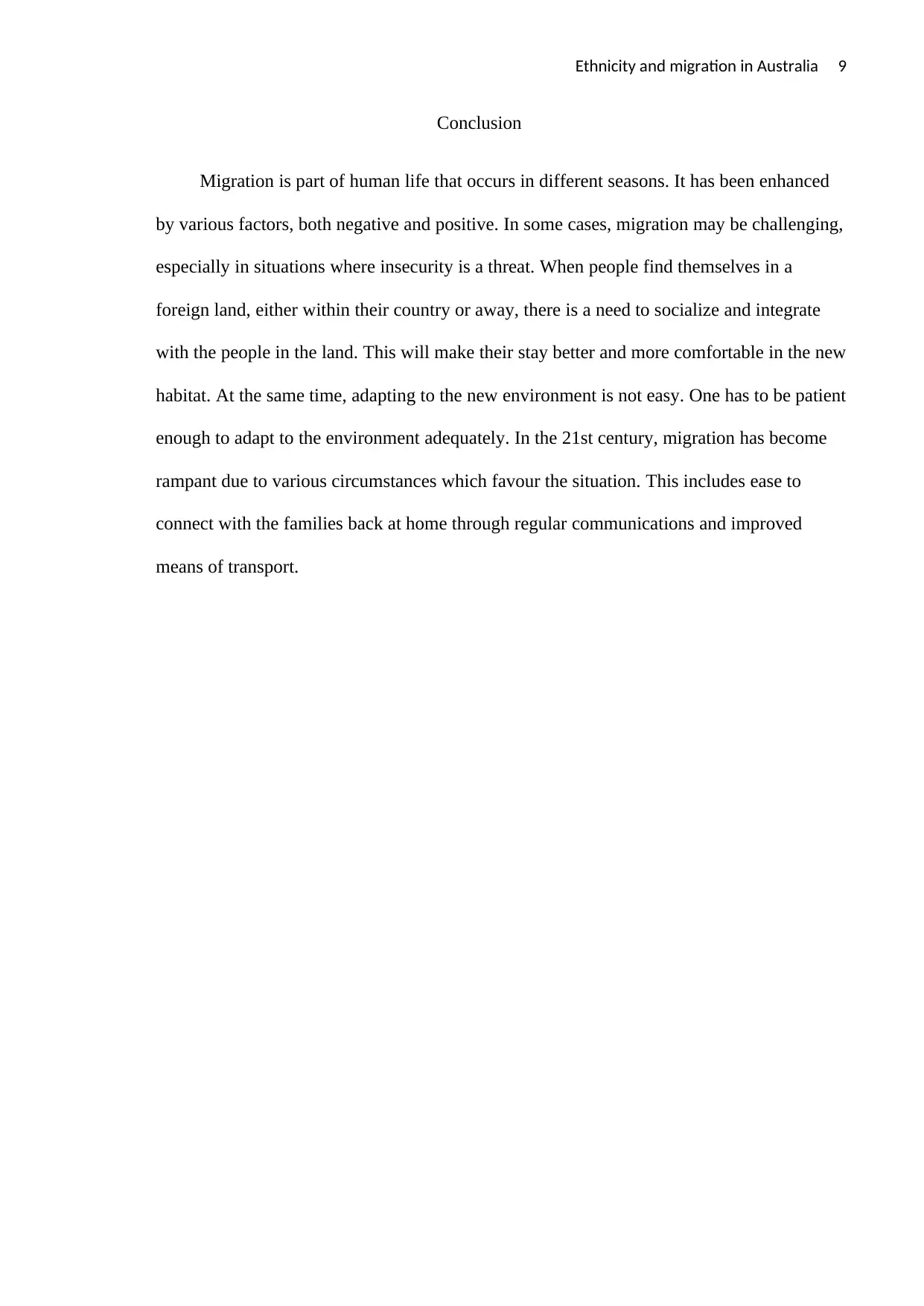
Ethnicity and migration in Australia 9
Conclusion
Migration is part of human life that occurs in different seasons. It has been enhanced
by various factors, both negative and positive. In some cases, migration may be challenging,
especially in situations where insecurity is a threat. When people find themselves in a
foreign land, either within their country or away, there is a need to socialize and integrate
with the people in the land. This will make their stay better and more comfortable in the new
habitat. At the same time, adapting to the new environment is not easy. One has to be patient
enough to adapt to the environment adequately. In the 21st century, migration has become
rampant due to various circumstances which favour the situation. This includes ease to
connect with the families back at home through regular communications and improved
means of transport.
Conclusion
Migration is part of human life that occurs in different seasons. It has been enhanced
by various factors, both negative and positive. In some cases, migration may be challenging,
especially in situations where insecurity is a threat. When people find themselves in a
foreign land, either within their country or away, there is a need to socialize and integrate
with the people in the land. This will make their stay better and more comfortable in the new
habitat. At the same time, adapting to the new environment is not easy. One has to be patient
enough to adapt to the environment adequately. In the 21st century, migration has become
rampant due to various circumstances which favour the situation. This includes ease to
connect with the families back at home through regular communications and improved
means of transport.
⊘ This is a preview!⊘
Do you want full access?
Subscribe today to unlock all pages.

Trusted by 1+ million students worldwide
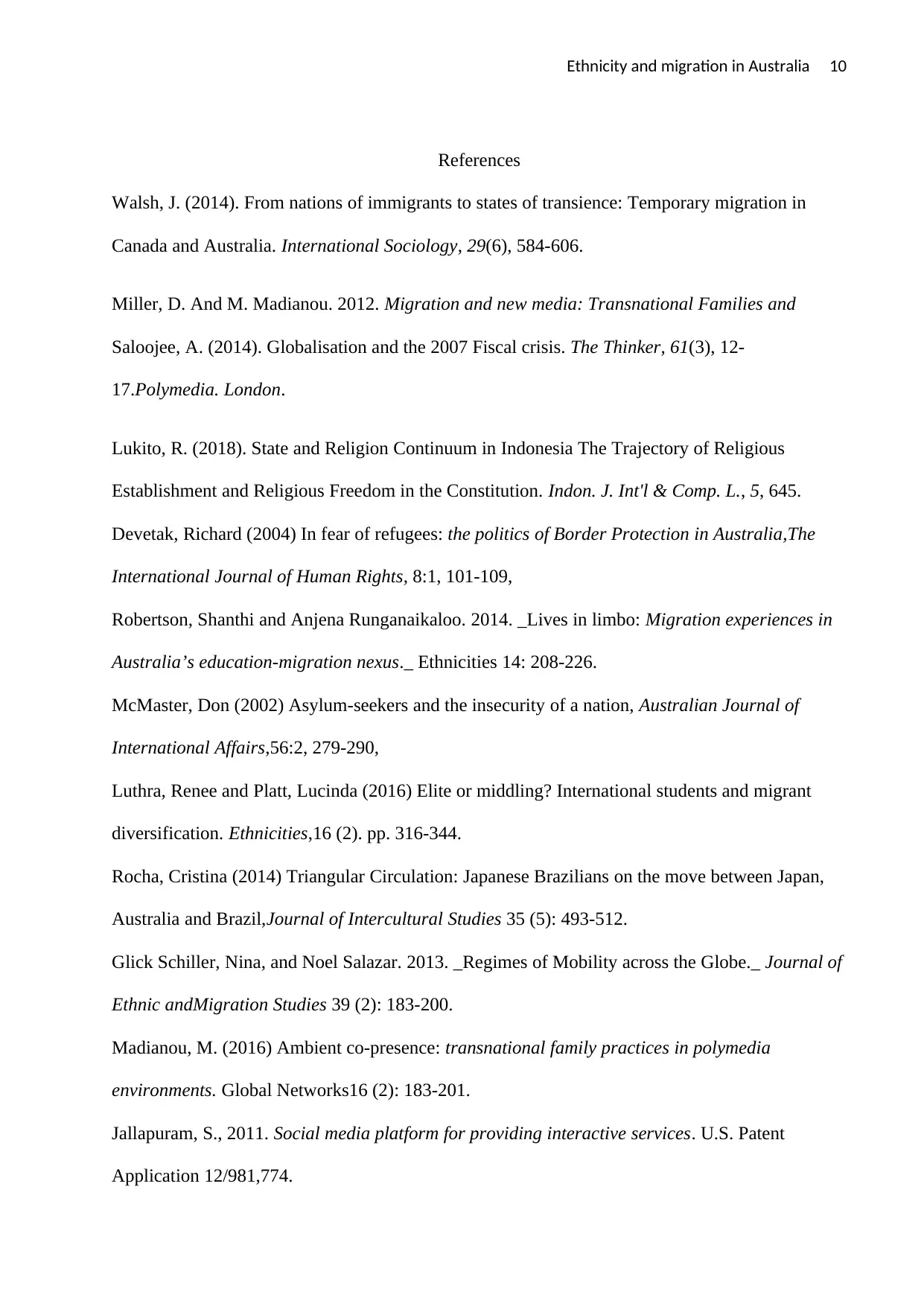
Ethnicity and migration in Australia 10
References
Walsh, J. (2014). From nations of immigrants to states of transience: Temporary migration in
Canada and Australia. International Sociology, 29(6), 584-606.
Miller, D. And M. Madianou. 2012. Migration and new media: Transnational Families and
Saloojee, A. (2014). Globalisation and the 2007 Fiscal crisis. The Thinker, 61(3), 12-
17.Polymedia. London.
Lukito, R. (2018). State and Religion Continuum in Indonesia The Trajectory of Religious
Establishment and Religious Freedom in the Constitution. Indon. J. Int'l & Comp. L., 5, 645.
Devetak, Richard (2004) In fear of refugees: the politics of Border Protection in Australia,The
International Journal of Human Rights, 8:1, 101-109,
Robertson, Shanthi and Anjena Runganaikaloo. 2014. _Lives in limbo: Migration experiences in
Australia’s education-migration nexus._ Ethnicities 14: 208-226.
McMaster, Don (2002) Asylum-seekers and the insecurity of a nation, Australian Journal of
International Affairs,56:2, 279-290,
Luthra, Renee and Platt, Lucinda (2016) Elite or middling? International students and migrant
diversification. Ethnicities,16 (2). pp. 316-344.
Rocha, Cristina (2014) Triangular Circulation: Japanese Brazilians on the move between Japan,
Australia and Brazil,Journal of Intercultural Studies 35 (5): 493-512.
Glick Schiller, Nina, and Noel Salazar. 2013. _Regimes of Mobility across the Globe._ Journal of
Ethnic andMigration Studies 39 (2): 183-200.
Madianou, M. (2016) Ambient co-presence: transnational family practices in polymedia
environments. Global Networks16 (2): 183-201.
Jallapuram, S., 2011. Social media platform for providing interactive services. U.S. Patent
Application 12/981,774.
References
Walsh, J. (2014). From nations of immigrants to states of transience: Temporary migration in
Canada and Australia. International Sociology, 29(6), 584-606.
Miller, D. And M. Madianou. 2012. Migration and new media: Transnational Families and
Saloojee, A. (2014). Globalisation and the 2007 Fiscal crisis. The Thinker, 61(3), 12-
17.Polymedia. London.
Lukito, R. (2018). State and Religion Continuum in Indonesia The Trajectory of Religious
Establishment and Religious Freedom in the Constitution. Indon. J. Int'l & Comp. L., 5, 645.
Devetak, Richard (2004) In fear of refugees: the politics of Border Protection in Australia,The
International Journal of Human Rights, 8:1, 101-109,
Robertson, Shanthi and Anjena Runganaikaloo. 2014. _Lives in limbo: Migration experiences in
Australia’s education-migration nexus._ Ethnicities 14: 208-226.
McMaster, Don (2002) Asylum-seekers and the insecurity of a nation, Australian Journal of
International Affairs,56:2, 279-290,
Luthra, Renee and Platt, Lucinda (2016) Elite or middling? International students and migrant
diversification. Ethnicities,16 (2). pp. 316-344.
Rocha, Cristina (2014) Triangular Circulation: Japanese Brazilians on the move between Japan,
Australia and Brazil,Journal of Intercultural Studies 35 (5): 493-512.
Glick Schiller, Nina, and Noel Salazar. 2013. _Regimes of Mobility across the Globe._ Journal of
Ethnic andMigration Studies 39 (2): 183-200.
Madianou, M. (2016) Ambient co-presence: transnational family practices in polymedia
environments. Global Networks16 (2): 183-201.
Jallapuram, S., 2011. Social media platform for providing interactive services. U.S. Patent
Application 12/981,774.
Paraphrase This Document
Need a fresh take? Get an instant paraphrase of this document with our AI Paraphraser
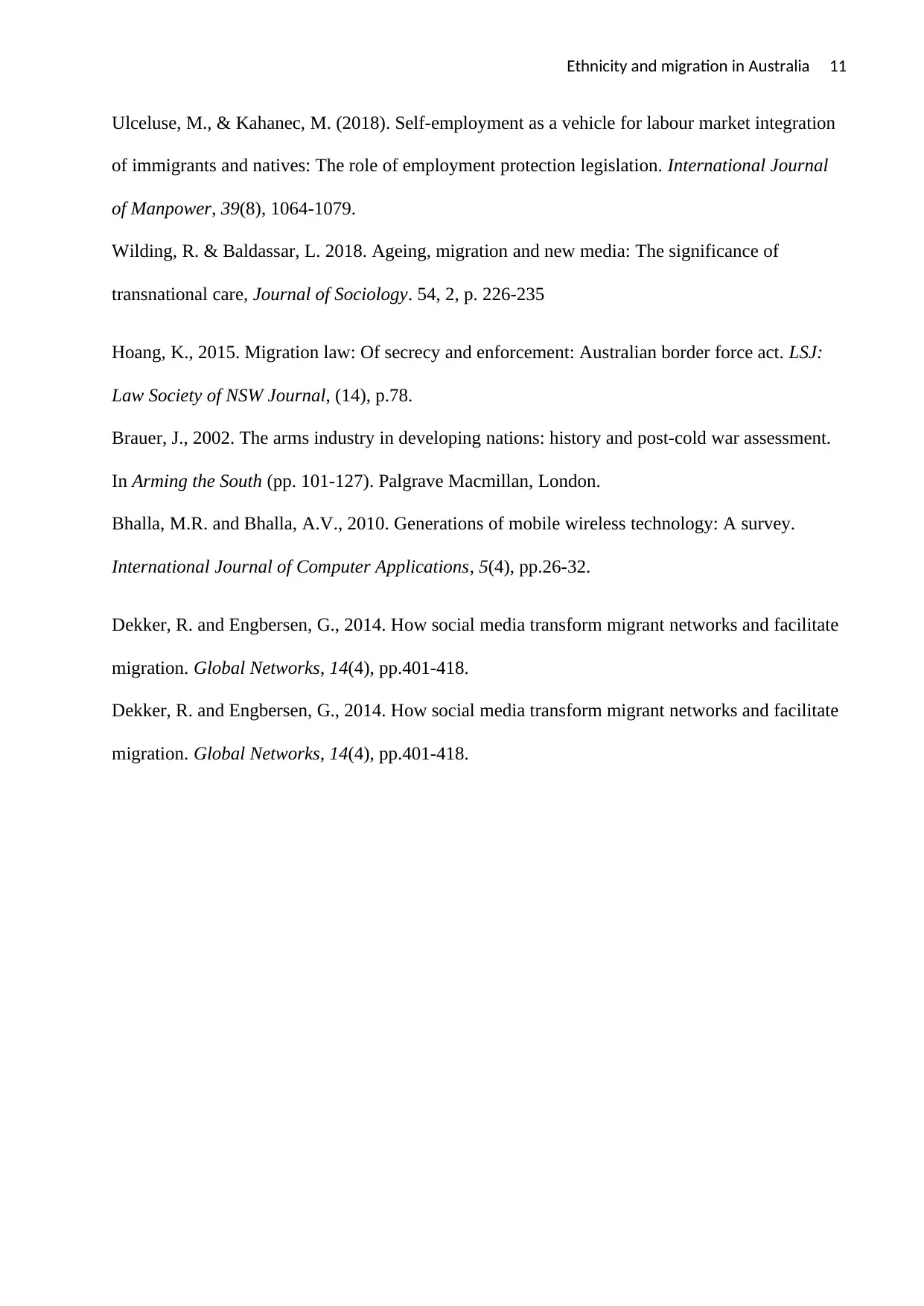
Ethnicity and migration in Australia 11
Ulceluse, M., & Kahanec, M. (2018). Self-employment as a vehicle for labour market integration
of immigrants and natives: The role of employment protection legislation. International Journal
of Manpower, 39(8), 1064-1079.
Wilding, R. & Baldassar, L. 2018. Ageing, migration and new media: The significance of
transnational care, Journal of Sociology. 54, 2, p. 226-235
Hoang, K., 2015. Migration law: Of secrecy and enforcement: Australian border force act. LSJ:
Law Society of NSW Journal, (14), p.78.
Brauer, J., 2002. The arms industry in developing nations: history and post-cold war assessment.
In Arming the South (pp. 101-127). Palgrave Macmillan, London.
Bhalla, M.R. and Bhalla, A.V., 2010. Generations of mobile wireless technology: A survey.
International Journal of Computer Applications, 5(4), pp.26-32.
Dekker, R. and Engbersen, G., 2014. How social media transform migrant networks and facilitate
migration. Global Networks, 14(4), pp.401-418.
Dekker, R. and Engbersen, G., 2014. How social media transform migrant networks and facilitate
migration. Global Networks, 14(4), pp.401-418.
Ulceluse, M., & Kahanec, M. (2018). Self-employment as a vehicle for labour market integration
of immigrants and natives: The role of employment protection legislation. International Journal
of Manpower, 39(8), 1064-1079.
Wilding, R. & Baldassar, L. 2018. Ageing, migration and new media: The significance of
transnational care, Journal of Sociology. 54, 2, p. 226-235
Hoang, K., 2015. Migration law: Of secrecy and enforcement: Australian border force act. LSJ:
Law Society of NSW Journal, (14), p.78.
Brauer, J., 2002. The arms industry in developing nations: history and post-cold war assessment.
In Arming the South (pp. 101-127). Palgrave Macmillan, London.
Bhalla, M.R. and Bhalla, A.V., 2010. Generations of mobile wireless technology: A survey.
International Journal of Computer Applications, 5(4), pp.26-32.
Dekker, R. and Engbersen, G., 2014. How social media transform migrant networks and facilitate
migration. Global Networks, 14(4), pp.401-418.
Dekker, R. and Engbersen, G., 2014. How social media transform migrant networks and facilitate
migration. Global Networks, 14(4), pp.401-418.
1 out of 11
Related Documents
Your All-in-One AI-Powered Toolkit for Academic Success.
+13062052269
info@desklib.com
Available 24*7 on WhatsApp / Email
![[object Object]](/_next/static/media/star-bottom.7253800d.svg)
Unlock your academic potential
Copyright © 2020–2025 A2Z Services. All Rights Reserved. Developed and managed by ZUCOL.





